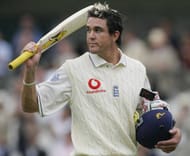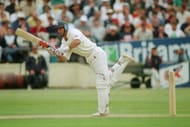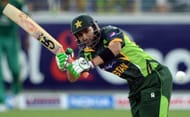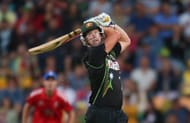Over the years, there have been numerous examples of cricketers who started out as bowlers but honed their batting ability with time and eventually became specialist batsmen for their sides. Often, young cricketers tend to be good at both disciplines and it takes them a bit of time to realise whether it is with the bat or the ball that they will truly succeed as cricketers.One such example is Steven Smith, who made his Test debut for Australia primarily as a leg spinner and batted at No.8. However, he realised that his bowling was not as consistent as is required at the highest level and his batting gradually started taking precedence, so much so that he has become the No.1 Test batsman in the world.Here are 5 players who started out as bowlers but became successful batsmen:
#1 Kevin Pietersen

In many ways, Kevin Pietersen is an antithesis to many stereotypes that have dogged English cricket over the years. Pietersen has managed to bypass the convention ever since he made his Test debut for England in that unforgettable 2005 Ashes triumph. Easily one of the most flamboyant English cricketers to have played the game, KP, with his swashbuckling approach and aggressive stroke-play, has tormented opposition bowlers across the world.
Known to be an entertainer at the crease, Pietersen has always banked on innovative shot-making to catch bowlers off-guard. The world caught a glimpse of his many talents when an ambidextrous KP peppered the boundary with two switch-hits that went for six in an ODI against New Zealand. A shot that has now become quite common among hard-hitting batsmen, KP’s proclivity for such new ideas has often been seen as a breath of fresh air in a team that occasionally struggles to keep up with the fluctuating demands of the sport.
A big-match player, Pietersen’s talent has come to the fore whenever England have been in rough waters. Be it pulling Brett Lee with utter disdain or shimming down the track to hit Shane Warne out of the park, the 2005 Ashes series was a heady start for Pietersen who was soon going to become the most sought-after player in English cricket.
Another delectable display of his batting came during a Test match at Lord’s in 2011 when he plundered a double hundred against a hapless Indian attack. Throughout his marathon innings, he kept the crowd on the edge of their seats with some sensational hitting.
Not to mention his liking for extravagant shots which meant that T20 was a format tailor-made for him. No surprise then that Pietersen played a pivotal role in England’s triumph at the World T20 in 2010 and was adjudged the Player of the Tournament for his irresistible display with the bat.
With 8181 runs from 104 Tests, which include 23 centuries and 35 half-centuries, and 4440 runs from 136 ODIs with nine centuries and 25 half-centuries, there’s no doubting Pietersen’s abilities with the bat. He’s the kind of batsman who can win a match on his own, put bowlers to the sword at will and can be daunting even at the face of apparent defeat.
In more than one way, he has been the perfect counterbalance to an English batting unit that has often been blamed for being too insipid in the shorter versions of the game.
Pietersen, who started his career as an off-spinner, fancies bowling spin now and then but has failed to match the standards that he has set for himself with the bat. He only has 17 wickets (10 in Tests, 7 in ODIs) from 240 international outings. Clearly, those figures don’t make for a very happy reading.
In light of the recent fallout between Pietersen and the ECB, the dashing batsman has been out of action for England and can only be seen playing T20 cricket sporadically.
However, one could only hope that the misunderstandings between KP and the board cease to exist so that England could again avail the services of one of its most charismatic and immensely gifted cricketers. And with England trying to kick the shackles that dogged their World Cup campaign this year, Pietersen could prove to be an active catalyst to get things going.
#2 Nasser Hussain

Nasser Hussain, one of England’s greatest captains and a fine batsman in his own right, began his career as a leg-spin bowler before switching trades. As a captain, he was feisty on the field but had a level head on his shoulders when it came to batting. A lot of natural talent, very good hands and a good eye made him a safe bet at the No.3 position in the Test side from where he anchored England to some famous wins.
An extremely talented leg-spinner in his early days, Hussain became the youngest ever player to be selected for Essex Under-15s. However, his bowling went pear-shaped when he grew in height all of a sudden. In his own words, "I went from bowling out Graham Gooch in the indoor school with everyone watching, to hitting the roof of the net or bowling triple-bouncers to deadly silence.”
Thankfully, though, he managed to hone his batting skills and carve out a fruitful international career. In the 96 Tests that he played, he scored 5764 runs at an average of 36.48, including 14 centuries and 33 half-centuries. Playing 88 ODIs, he accumulated 2332 runs at an average of 30.29 with one century and 16 half-centuries.
#3 Steven Smith

From a rookie leg-spinner bowling filth more often than not to being appointed Australia’s Test captain in the absence of Michael Clarke recently, Steven Smith has come a long way. After all, it was not long ago that his role in the side was a question of big debate. Smith, who was given his chance on the international stage as a specialist leggie in 2010, was used as a floating all-rounder during the disastrous Ashes series of 2010-11.
Australian cricket was at its lowest point and with three innings losses at home to England, heads were going to roll. Smith was one of the many casualties in the aftermath of that debacle and didn’t play a Test match for the next two years until he was named in Australia’s 17-man squad for the Indian tour in 2013; this time just as a backup batsman. From thereon, Smith has made giant strides as a batsman and has become the pivot around which the team’s fortunes have revolved. His meteoric rise in international cricket is an amalgamation of his talent and hard work.
Known for his tendency to poke at balls outside off-stump, Smith appeared to be a walking wicket early on in his career but a tweak in his technique and hours of hard work in the nets have dramatically changed his fortunes as a batsman. He has achieved all this by being different; by not confining himself to the classic tenets of batting.
In a stance that’s peculiar at best, Smith takes a leg-stump guard and shuffles across while the bowler’s still in his delivery stride. Just before the ball comes out of the bowler’s arm, he takes residence around middle and off-stump and works the ball effortlessly to all parts of the ground.
Anything on the off-stump is flicked to the on-side and if bowlers try to compensate by going wide of the wicket, he merrily flays them past the cover region for runs. Such utterly impregnable his batting has looked in the past 14 months or so, it came as no surprise to anyone when Smith recently became the No.1 ranked Test batsman in the world.
In a Test career that’s still in its infancy, Smith has played in 28 matches and has scored 2587 runs, with 9 centuries and 11 half-centuries, at an outstanding average of 56.24. In addition, he has scored 1549 runs from 58 ODIs at an average of 40.76 with four centuries and 7 half-centuries at a healthy strike rate of 89.38, validating his dexterity in both the formats.
His performance in the past 12 months, particularly since the back end of 2014, has been rather phenomenal, highlighted by the fact that Smith scored two half-centuries and one century in the knockout stages of the World Cup.
While he’s busy brandishing his willow tormenting bowlers with his immaculate stroke-making, it is possible one may forget the fact that Smith’s first exploits in international cricket were as a leg-spinner. A tally of 15 wickets from 28 Tests at an economy of 4.34 and 27 wickets from 58 ODIs at an economy of 5.26 substantiate the fact that batting has always been Smith’s stronger suit.
However, having achieved great feats with the bat, Smith has set sights on improving his leg-spin so that he can become a true all-round talent.
Needless to say, Smith is the crown-jewel of the current Australian side and is boisterously headed towards becoming one of the greats of the game.
#4 Shoaib Malik

If one were to jog their memories back to 1999, we will be reminded of a young Shoaib Malik outsmarting the opposition batsmen with the bewildering ‘doosra’. That he had the guile and flight of a classical off-spinner didn’t deter him from using his variations to explore fissures in a batsman’s defence. Over time, though, Malik’s batting has overtaken his bowling and he bowls only occasionally nowadays.
As a batsman, Malik at his best could thread the tiniest gap between fielders with precision, lofting the ball over the in-field now and then, pressing the foot on the pedal when the situation demanded. He may not have been as graceful as Mohammad Yousuf or as belligerent as Shahid Afridi but was surely just as effective with the bat as any of his other esteemed colleagues.
Being a player who was born and brought up on the sluggish sub-continent pitches, Malik was particularly strong against spin using his feet regularly to work the ball around. That he got lost in the wilderness because of haphazard selection policies and an inner rift within his own cricket board is rather unfortunate.
Although he wasn’t picked in the side for the 2003 ICC Cricket World Cup, he essayed a fine comeback in the 2004 Asia Cup scoring heaps of runs playing an instrumental role in Pakistan’s victory. He has donned the Pakistan cap in 219 ODIs, scoring 5641 runs at an average of 32.99 with eight centuries and 31 half-centuries.
He has had his moments of glory in Test cricket as well but with a technique that was found wanting in seaming conditions, he has failed to leave much of an impression in the longer format.
Malik has played 32 Tests from which he has scored 1606 runs at an average of 33.46 with two centuries and 8 half-centuries. Malik, who enjoyed success as an off-spinner during his early days, has picked 21 wickets from 32 Tests at an economy of 3.45 and 143 wickets from 219 ODIs at an economy of 4.56.
As is evident, Malik has briefly sparkled in every facet of the game but has failed to leave a lasting impression in one department. For a player who made his debut as a promising off-break bowler, developing batting skills to become a top-order batsman is no mean achievement, though.
#5 Cameron White

A shrewd cricketer with an amazing appetite for big hitting, Cameron White can invoke fear in the opposition when he gets going, which he sadly hasn’t been able to do too often in the recent past.
Drafted into the Australian Test side as a leg-spinner who could bat during the India series in 2008, White never looked like a long-term option. With a stock ball that was barely alarming and a straighter one that he pushed through the air hoping to trap the batsman leg before the wicket, he just did not have the variation required to succeed as a spinner at the highest level.
In the 4 Tests that he played, he took merely 5 wickets at an economy of 3.68.
However, he has had success for Australia with the bat. Although his stay out in the middle has always appeared dicey, he likes using the long handle and is at his best when he is taking the attack to the opposition. There was a time when White managed to establish himself as a permanent member of the ODI side, proving to be a valuable presence in the middle order.
While his stint was not as long as he would have liked it to be, he can be proud of the fact that he has scored 2037 runs from 88 ODIs at a healthy average just under 35.
Follow IPL Auction 2025 Live Updates, News & Biddings at Sportskeeda. Get the fastest updates on Mega-Auction and cricket news
